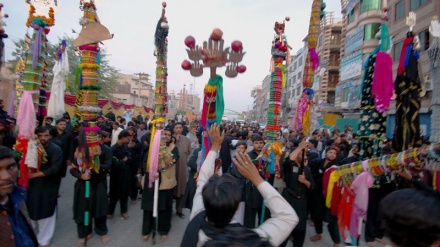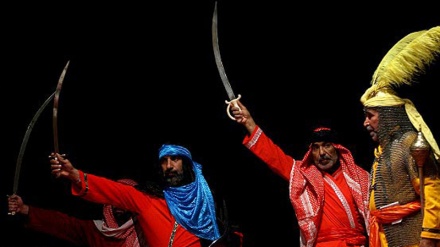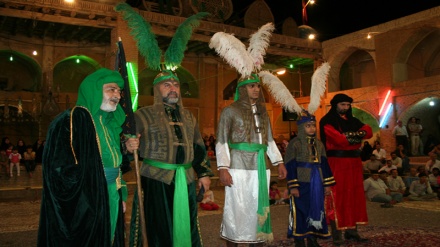Muharram mourning traditions in different lands - 16
We continue to discuss the Muharram mourning ceremonies in the kingdom of Awadh in what is now the Uttar Pradesh state, which was ruled by the Naishapuri Seyyed Family of Iranian origin.
The founding of the kingdom of Awadh by Burhan ol-Molk, who was a migrant from Khorasan, transformed the culture of Lucknow, Fayzabad, and other towns and cities, as Shi’a Islam became the state religion. The leading Mujtahid was Seyyed Dildar Ali Nasirabadi, who built an Imambara or Hussainiyah around 1790. In the subsequent years, other such centres of mourning ceremonies were built by the notables and the ruling family. Here the ulema often held sessions, where they narrated the sufferings of martyrs based on hadith and the early historical sources. This style was known as Hadis-Khwani.
In the early 1800s Seyyed Mohammad Nasirabadi, then Lucknow's chief mujtahid, recited reports from the Infallible Imams in Arabic with translations in Persian and Urdu. On the tenth of Muharram or Ashura, the calamities that befell Imam Husain (AS) were recited, with the whole audience weeping. Then he descended from the minbar, barefoot, bareheaded, tears streaming from ruddy cheeks. After this the Noha-Khwani or reciting of elegies to the rhythmical beating of the chests was started. People of all classes took part, including the illiterate, who could understand the verses. Readers presented verse works commemorating the martyrdom of the Imam Husain (AS) in various rhetorical styles. The ulama favored the straightforward reading of the poetry called “taht-al-lafz-khwani. Another style, antedating in India the rise of Shi‘i culture in Awadh, involved the chanting of souz-khwani of elegies. The mourning session concluded with a frenzied period of self-flagellation called the ma'tam.
The mourning sessions held in homes during Muharram and during other months provided crucial opportunities for the development of social networks among Shi’a Muslims, whether male or female, notable or commoner. Mourners went from session to session, spreading news and giving people of one neighborhood or village a sense of unity with their coreligionists elsewhere. Lucknow became a place where Shi’a Muslims from all over Awadh could meet at Muharram and thus overcome their sense of being minority communities. The sessions reflected in their social composition the class and status of the host. Within social classes and neighborhoods, the sessions did much to foster a sense of community identity.
During the first ten days of Muharram, people would devoutly visit the Imambaras. Multitudes crowded the streets and lanes, most on foot, but with some notables on horseback or in palanquins, making social rounds, visiting cenotaphs, and participating in the twice-daily mourning sessions. On the third day of Muharram women sent sweet dishes to friends and relatives, as well as to poor families, in remembrance of the Martyrs of Karbala. They repeated this on the seventh and fortieth days after the first of Muharram. On the fifth of Muharram believers took out processions throughout Lucknow to Rustamnagar, where they had their standards blessed at the replica of the shrine of Hazrat Abbas (AS).
At the head of the procession walked a guard of soldiers around four elephants, which carried men and silk-and-gold banners. In the train of the elephants came a band playing instruments and trumpets with doleful tones, accompanied by reciters of elegies. The verses chosen for the procession particularly concerned the sufferings of Hazrat Abbas (AS). Thereafter came a horse, representing the Imam’s steed. His legs were stained with red, and arrows appeared to be stuck in various parts of his body. A turban rode on the tragically empty saddle.
The climax of the mourning period came on the tenth day, that is, Ashura, the anniversary of the heartrending tragedy of Karbala. Participants rose in the early hours of the morning and began preparing for the procession, women sometimes lighting candles at the cenotaph before dawn and making requests. At dawn the mourners set out for a symbolic burial ground on the outskirts of the city, called a Karbala. In Safavid Iran, the laboring classes participated in street processions; the wealthy favored the mourning sessions inside.
In Awadh, however, many notables joined the street processions with great fervor. The wealthy put together a military funeral parade, with elephants, bands, a bearer of the sword staff, banners, and a caparisoned and bloodstained horse with a royal umbrella above his head. People walked behind reciting elegies and beating their chests in grief, often bare-headed and barefoot. From time to time the procession would halt, sometimes as often as every five minutes. Then the notables listened to the elegies being chanted, or mourners flagellated themselves to the accompaniment of drums. The ulema took a critical attitude toward some of the Muharram practices.
In 1808 the Iranian immigrant scholar Aqa Ahmad Behbahani endeavored to convince notables in Fayzabad to give up the practice of beating drums to the accompaniment of their breast-beating. Widespread, though not universal, Sunni and Hindu participation in the mourning ceremonies of Awadh made Muharram rites trans-communal. Sunnis greatly respect Imam Husain (AS), as the grandson of Prophet Mohammad (SAWA). They would shed tears for the Martyr of Karbala, but not beat their chests.
MD/AS/SS


